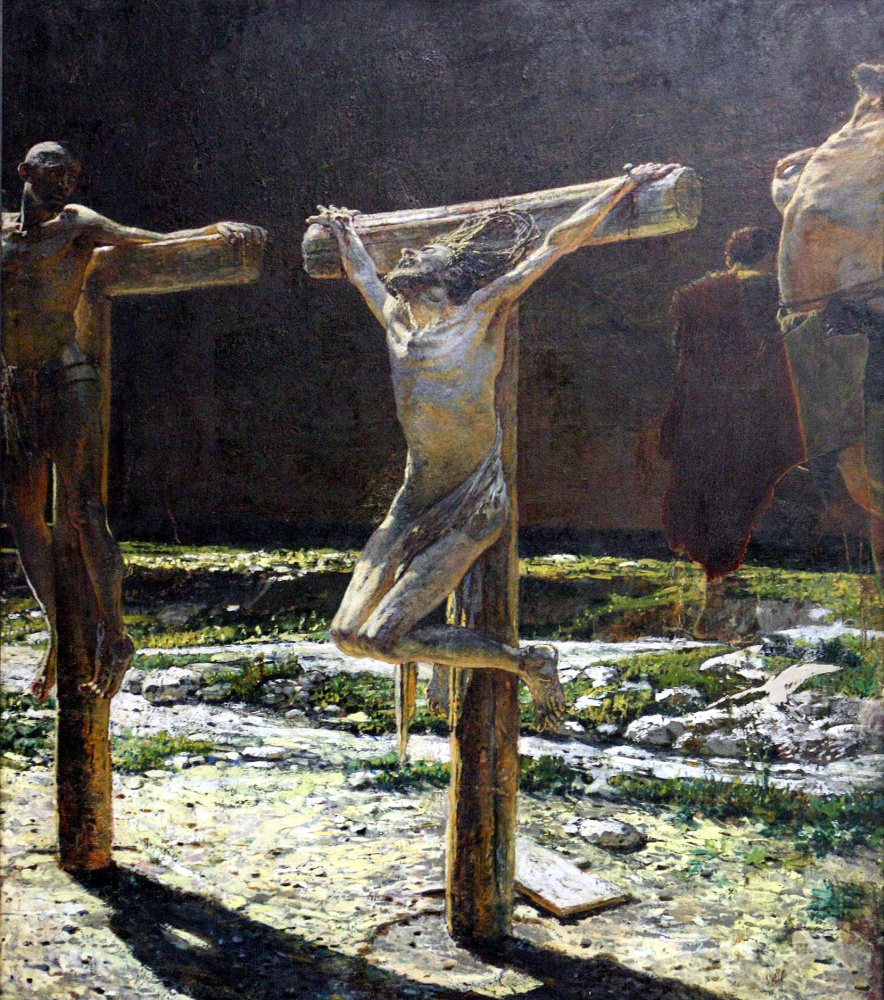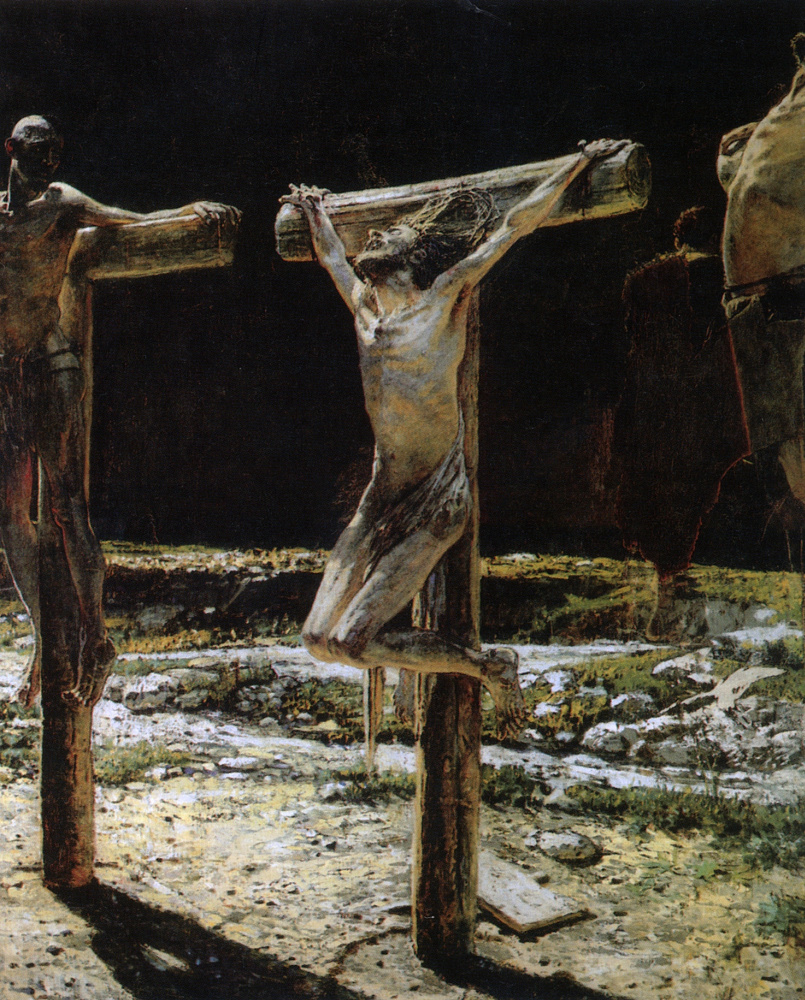log in
Enter site
Login to use Arthive functionality to the maximum
The crucifixion
Nikolai Nikolaevich Ge • Painting, 1892, 280×225 cm
Description of the artwork «The crucifixion»
"Nicholas started to write "the Crucifixion" in 1884, the year– says daughter-in-law GE, Catherine, – and I never thought he was this painting wrote: so much he rewrote it and so with her pain. All were dissatisfied expression of his thoughts".
The last days of the earthly life of the Savior (the passion of the Christ) have become a Central theme in the later works of GE. But none of his works, "the passion" did not find approval or understanding of his contemporaries. For example, a picture "What is truth?"removed from the XVIII traveling exhibition "Sanhedrin court"forbidden to exhibit, and "Crucifixion" in General was not allowed to the General public. Known reaction of Emperor Alexander III at this picture of GE. According to one memoir versions, he uttered only one word: "A massacre!" The other group, commented: "...we still somehow understand, but people... he will never appreciate, it will never be clear".
But we must pay tribute to of hardness GE: he never tried to adapt to the tastes of the General public, trusting more their own taste and feel than the opinions of others. For this reason, GE very seldom worked to order, he needed creative freedom. He confessed that all his life tried to write of Christ, "who lives in his soul."and then mocked him: "But my flesh is weak, so write portraits".
The theme of the crucifixion was for Kye particularly important, but particularly challenging: on different versions of the painting he worked until the last days of his life. To put "Crucifixion" was officially impossible, because GE was showing "inappropriate" picture in the apartments of friends.
Leo Tolstoy saw the "Crucifixion" in the house Strannolyubsky, acquaintances who have agreed to "shelter" themselves from the disgraced cloth, and found that it's best "Crucifixion" in the world of painting: "The first time I saw (finally!) the picture of this terrible tragedy, in all its untidy nesongano and horror. I could not get away from the picture and never forgot the first incomparable impressions. How many thousands of paintings of "decent" and "not offending anyone", but entire galleries and museums I would give for one this picture is insulting the huge crowds of people, the audience, almost everyone."
The path of "Crucifixion" in France
Variants of the "Crucifixion" was created, the fate of some of them are still not known. The image of the head of the crucified Christ (1, 2), which are preliminary sketches to a large "Crucifixion", are stored in the Kiev Museum of Russian art. Well, the version of "crucifixion" of 1892, the year did unusual and a long way from the Ukrainian village of Ivanovskoe, where Nikolai GE lived the last 18 years of his life, to the Paris Museum d'orsay.
After the sudden death in 1894, his sons were faced with the problem of preserving his father's legacy. Wills Kyo left, and on the paintings of "the passion" is under threat of seizure: the police could confiscate "unreliable". Came to the rescue of Leo Tolstoy. He offered to hide the picture of Kye in Yasnaya Polyana. Children Kye agreed and moved the work of his father in the Studio of Tatiana Lvovna, a daughter of the writer. Thick few years had sent numerous letters Pavel Tretyakovpersuading to buy GE and maybe in the future to create a Museum of the artist. Tretyakov answered reluctantly, not hide the fact that late work GE he does not understand and finds it "non-fiction", but under pressure of prestige of Tolstoy agreed to accept the paintings and drawings in its collection, but their exposition is that speech could not be. In 1898 Tretyakov died and his heirs did not object, when the sons of GE wished to regain part of the collection, among them "the Crucifixion" of 1892. In 1900, the son of GE, also Nicholas, like his father, moved from Russia to Switzerland and brought with him a part of his father's works. In Russia the younger GE never came back. Over time, he will receive French citizenship (after all, his great-grandfather Mathieu GE was French). His son Ivan (grandson of the artist) will fight in the First world war on the side of the French army and die. In memoriam Nikolai GE the younger gave his father's Crucifixion by the churches of that French town, where they buried Ivan. Only in 1981, the year the picture came to the national Museum of modern art in Paris, and from there was transferred to the d'orsay.
Author: Anna Yesterday
The last days of the earthly life of the Savior (the passion of the Christ) have become a Central theme in the later works of GE. But none of his works, "the passion" did not find approval or understanding of his contemporaries. For example, a picture "What is truth?"removed from the XVIII traveling exhibition "Sanhedrin court"forbidden to exhibit, and "Crucifixion" in General was not allowed to the General public. Known reaction of Emperor Alexander III at this picture of GE. According to one memoir versions, he uttered only one word: "A massacre!" The other group, commented: "...we still somehow understand, but people... he will never appreciate, it will never be clear".
But we must pay tribute to of hardness GE: he never tried to adapt to the tastes of the General public, trusting more their own taste and feel than the opinions of others. For this reason, GE very seldom worked to order, he needed creative freedom. He confessed that all his life tried to write of Christ, "who lives in his soul."and then mocked him: "But my flesh is weak, so write portraits".
The theme of the crucifixion was for Kye particularly important, but particularly challenging: on different versions of the painting he worked until the last days of his life. To put "Crucifixion" was officially impossible, because GE was showing "inappropriate" picture in the apartments of friends.
Leo Tolstoy saw the "Crucifixion" in the house Strannolyubsky, acquaintances who have agreed to "shelter" themselves from the disgraced cloth, and found that it's best "Crucifixion" in the world of painting: "The first time I saw (finally!) the picture of this terrible tragedy, in all its untidy nesongano and horror. I could not get away from the picture and never forgot the first incomparable impressions. How many thousands of paintings of "decent" and "not offending anyone", but entire galleries and museums I would give for one this picture is insulting the huge crowds of people, the audience, almost everyone."
The path of "Crucifixion" in France
Variants of the "Crucifixion" was created, the fate of some of them are still not known. The image of the head of the crucified Christ (1, 2), which are preliminary sketches to a large "Crucifixion", are stored in the Kiev Museum of Russian art. Well, the version of "crucifixion" of 1892, the year did unusual and a long way from the Ukrainian village of Ivanovskoe, where Nikolai GE lived the last 18 years of his life, to the Paris Museum d'orsay.
After the sudden death in 1894, his sons were faced with the problem of preserving his father's legacy. Wills Kyo left, and on the paintings of "the passion" is under threat of seizure: the police could confiscate "unreliable". Came to the rescue of Leo Tolstoy. He offered to hide the picture of Kye in Yasnaya Polyana. Children Kye agreed and moved the work of his father in the Studio of Tatiana Lvovna, a daughter of the writer. Thick few years had sent numerous letters Pavel Tretyakovpersuading to buy GE and maybe in the future to create a Museum of the artist. Tretyakov answered reluctantly, not hide the fact that late work GE he does not understand and finds it "non-fiction", but under pressure of prestige of Tolstoy agreed to accept the paintings and drawings in its collection, but their exposition is that speech could not be. In 1898 Tretyakov died and his heirs did not object, when the sons of GE wished to regain part of the collection, among them "the Crucifixion" of 1892. In 1900, the son of GE, also Nicholas, like his father, moved from Russia to Switzerland and brought with him a part of his father's works. In Russia the younger GE never came back. Over time, he will receive French citizenship (after all, his great-grandfather Mathieu GE was French). His son Ivan (grandson of the artist) will fight in the First world war on the side of the French army and die. In memoriam Nikolai GE the younger gave his father's Crucifixion by the churches of that French town, where they buried Ivan. Only in 1981, the year the picture came to the national Museum of modern art in Paris, and from there was transferred to the d'orsay.
Author: Anna Yesterday





